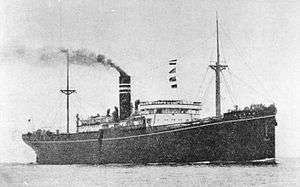Lisbon Maru
 | |
| History | |
|---|---|
| Name: | SS Lisbon Maru |
| Owner: |
|
| Builder: | Yokohama Dock Company, Yokohama |
| Laid down: | 15 October 1919 |
| Launched: | 31 May 1920 |
| Completed: | 8 July 1920 |
| Fate: | Torpedoed off Dongfushan in the Zhoushan Archipelago 1 October, and sank on 2 October 1942 |
| General characteristics | |
| Class and type: | Cargo liner |
| Tonnage: | 7,053 GRT |
| Length: | 135.6 m (444 ft 11 in) |
| Beam: | 17.7 m (58 ft 1 in) |
| Depth: | 10.4 m (34 ft 1 in) |
| Installed power: | 632 nhp |
| Propulsion: | 2 × triple expansion steam engines |
| Speed: | 12 knots (22 km/h; 14 mph) |
| Capacity: | 28 passengers |
Lisbon Maru (りすぼん丸) was a Japanese Cargo liner built at Yokohama in 1920 for a Japanese shipping line. During World War 2 the ship became an armed troopship. On her final voyage Lisbon Maru was also transporting prisoners-of-war between Hong Kong and Japan when torpedoed on 1 October 1942, sinking with a loss of over 800 lives.[1]
Construction and commercial service
Lisbon Maru was completed on 8 July 1920 at the Yokohama Dock Company shipyard in Yokohama, Japan as Yard No. 70, entering service for a major Japanese shipping line, Nippon Yusen Kabushiki Kaisha, and registered at the port of Tokyo.[2][3]
The ship was 445 feet (135.6 metres) long, with a beam of 58 ft (17.7 m) and a depth of 34 ft (10.4 m). The ship measured 7,053 GRT and 4,308 NRT. Twin propellers were powered by a pair of triple expansion steam engines with a combined rating of 632 nhp, giving a service speed of 12 knots (22 km/h; 14 mph). The engines and four boilers were made by the shipbuilder.[2][3]
Sinking
On her final voyage she was carrying, in addition to 700 Japanese Army personnel, 1,816 British and Canadian prisoners of war captured after the fall of Hong Kong in December 1941. The POWs were held in "appalling conditions ... [those] at the bottom of the hold ... showered by the diarrhoea of sick soldiers above".[4]
On 1 October 1942 the ship was torpedoed by USS Grouper (SS-214). The Japanese troops were evacuated from the ship but the POWs were not; instead the hatches were battened down above them and they were left on the listing ship. After 24 hours it became apparent that the ship was sinking and the POWs were able to break through the hatch covers. Some were able to escape from the ship before it sank. The ladder from one of the holds to the deck failed, and the Royal Artillery POWs in the hold could not escape; they were last heard singing "It's a Long Way to Tipperary". Survivors reported that Japanese guards first fired on the POWs who reached the deck; and that other Japanese ships used machine guns to fire at POWs who were in the water. Later, however, after some Chinese fishermen started rescuing survivors, the Japanese ships also rescued survivors.[4]
The British government insisted that over 800 of these men died either directly as a result of the sinking, or were shot or otherwise killed by the Japanese while swimming away from the wreck. The ship was not marked to alert Allied forces to the nature of its passengers. However, over 1,000 Allied prisoners were rescued by the Japanese military. The Japanese Government insisted that British prisoners were in fact not deliberately killed by Japanese soldiers and chastised the British Government.
Aftermath
A memorial was placed in the chapel of Stanley Fort, Hong Kong, which was moved to the chapel of St. Stephen's College, Hong Kong, due to Hong Kong's change in sovereignty.
A reunion of survivors was held on board HMS Belfast on 2 October 2007 to mark the 65th anniversary of their escape. Six former prisoners attended, alongside many bereaved families of the escapees.
See also
References
- ↑ http://www.lisbonmaru.com/
- 1 2 "Lisbon Maru". Miramar Ship Index (subscription required). Wellington, New Zealand: R B Haworth. Retrieved 14 July 2018.
- 1 2 "Lloyd's Register of Ships: Steam & Motor Ships" (PDF). Plimsoll Ship Data. Lloyd's Register of Shipping. 1930. Retrieved 14 July 2018.
- 1 2 Unia, Emily; Mulvey, Stephen (14 July 2018). "British POWs sank with the Lisbon Maru - should it be raised?". BBC News. Retrieved 14 July 2018.
Further reading
- Tony Banham (2006). The Sinking of the Lisbon Maru: Britain's Forgotten Wartime Tragedy. Hong Kong University Press. ISBN 978-962-209-771-1.
External links
- The fall of Hong Kong which led to transportation of prisoners on the Lisbon Maru
- The full roll of those who perished on the Lisbon Maru
- Sinking of Lisbon Maru
- Time to Unseal the Lison Maru Incident, an incomplete documentation of the rescue effort made by local Chinese fishermen
- IWM Interview with survivor George Bainborough
- IWM Interview with survivor Jack Hughieson
- IWM Interview with survivor Charles Jordan
- IMW Interview with survivor Andrew Salmon
- IWM Interview with survivor Montague Truscott
- IWM Interview with survivor Alf Shepherd